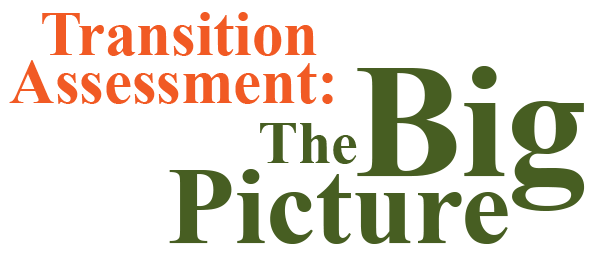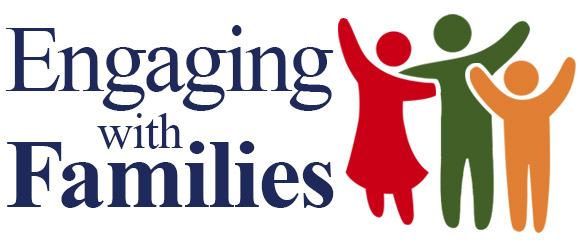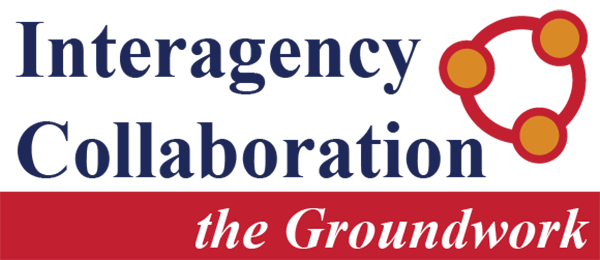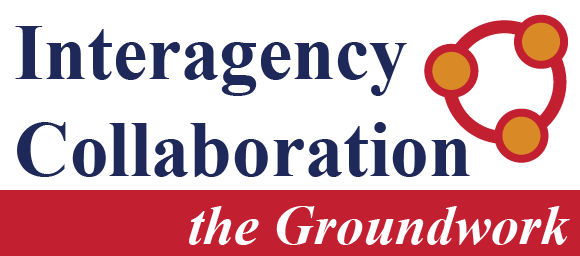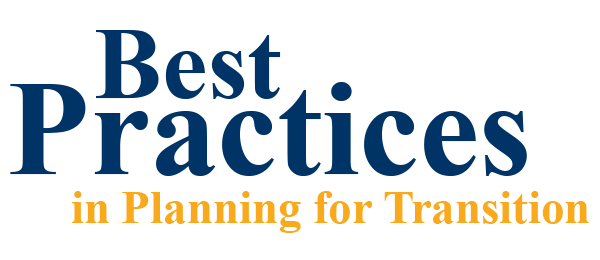Open to access this content
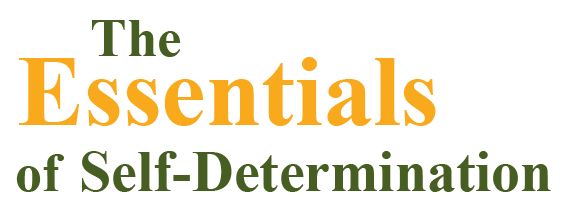
Reference this module as:
Lattin, D.L., Morningstar, M.E, Field, S., Bjorkman Wade, D.K. & Hu, X. (2010). The essentials of self-determination [Online Training Module]. Lawrence, KS: University of Kansas, Department of Special Education. Retrieved from: www.transitioncoalition.org
All contents Copyright 2010 by the Transition Coalition
References:
Reference this module as:
Noonan, P., Morningstar, M.E., and Clark, G. (2009). Transition assessment: The big picture. [Online Training Module]. Lawrence, KS: University of Kansas, Department of Special Education. Retrieved from: https://transitioncoalition.org
References:
Black, R. S., & Ornelles, C. (2001). Assessment of social competence and social networks for transition. Assessment for Effective Intervention, 26(4), 23-29.
Clark, G. M. (2007). Assessment for transitions planning (2nd ed.). Austin, TX: Pro-ED.
Daniels, V. I. (1999). The assessment maze: Making instructional decisions about alternative assessments for students with disabilities. Preventing School Failure, 43(4), 171-178.
Mount, B. (1992). Person-centered planning: Finding directions for change using Personal Futures Planning. New York: Graphic Futures.
Sax, C. L., & Thoma, C. A. (2001). Transition assessment: Wise practices for quality lives. Baltimore, MD: Brookes Publishing Company.
Sitlington, P. L. (1996). Transition assessment: Where have we been and where should we be going? Career Development for Exceptional Individuals, 19(2), 159-168.
Sitlington, P. L., Clark, G. M. (2001). Career/vocational assessment: A critical component of transition planning. Assessment for Effective Intervention, 26(4), 5-22.
Sitlington, P. L., Neubert, D. A., & Leconte, P. J. (1997). Transition assessment: The position of the Division on Career Development and Transition. Career Development for Exceptional Individuals, 20, 69-79.
Vandercook, T., York, J. & Forest, M. (1989). The McGill Action Planning System: A strategy for building a vision. Journal of the Association for People with Severe Handicaps, 14(3), 205-215.
Engaging with Families – Credits and References
Reference this module as:
Morningstar, M.E. & Wilt, C. (2021). Engaging with families. [Online Training Module]. Lawrence, KS: University of Kansas, Life Span Institute. Retrieved from: www.transitioncoalition.org
References:
Allen, Q., & White-Smith, K. (2018). “That’s why I say stay in school”: Black mothers’ parental involvement, cultural wealth, and exclusion in their son’s schooling. Urban Education, 53(3), 409-435.
Annamma, S. A., Anyon, Y., Joseph, N. M., Farrar, J., Greer, E., Downing, B., & Simmons, J. (2019). Black Girls and School Discipline: The Complexities of Being Overrepresented and Understudied. Urban Education, 54(2), 211–242. https://doi.org/10.1177/0042085916646610
Annamma, S., Morrison, D., & Jackson, D. (2014). Disproportionality fills in the gaps: Connections between achievement, discipline and special education in the school-to-prison pipeline. Berkeley Review of Education, 5(1), 53-87.
Banks, J. A., & Banks, C. A. M. (Eds.). (2019). Multicultural education: Issues and perspectives. John Wiley & Sons.
Bell, J. (2016, April 25). 5 Things to Know About Communities of Color and Environmental Justice. https://www.americanprogress.org/article/5-things-to-know-about-communities-of-color-and-environmental-justice/
Burdge, H., Licona, A. C., Hyemingway, Z. T. (2014). LGBTQ Youth of Color: Discipline Disparities, School Push-Out, and the School-to-Prison Pipeline. San Francisco, CA: Gay-Straight Alliance Network and Tucson, AZ: Crossroads Collaborative at the University of Arizona.
Bureau of Labor Statistics, U.S. Department of Labor. (2021, March 2) The Economics Daily, 17.9 percent of people with a disability employed in 2020. https://www.bls.gov/opub/ted/2021/17-9-percent-of-people-with-a-disability-employed-in-2020.htm
Carlson, S. R., & Wilt, C. L. (2020). Learning about and qualifying for Home and Community-Based Services Waivers: Families’ perspectives and experiences. Journal of Vocational Rehabilitation, 53(1), 17-28.
Carvalho, L. S., Meier, S., & Wang, S. W. (2016). Poverty and economic decision-making: Evidence from changes in financial resources at payday. American economic review, 106(2), 260-284.
Crenshaw, K. (1989). Demarginalizing the intersection of race and sex: A black feminist critique of antidiscrimination doctrine, feminist theory and antiracist politics. u. Chi. Legal f., 139.
Data USA. (2020). Vocational rehabilitation services: Diversity. Retrieved April 10, 2023, from https://datausa.io/profile/naics/vocational-rehabilitation-services#demographics
Delman, J. (2019). Disparities in vocational supports for Black young adults with mental health conditions. Worcester, MA: University of Massachusetts Medical School, Department of Psychiatry, Transitions to Adulthood Center for Research.
DOED Civil Rights Data Collection. (2018). Data snapshot: school discipline.
Fracassini, E. (2018). Checking yourself for bias in the classroom. Learning for Justice. https://www.learningforjustice.org/magazine/checking-yourself-for-bias-in-the-classroom
Harry, B., & Ocasio-Stoutenburg, L. (2020). Meeting families where they are: Building equity through advocacy with diverse schools and communities. Disability, Culture, and Equity.
Jameel, M., & Yerardi, J. (2019). Despite legal protections, most workers who face discrimination are on their own. The Center for Public Integrity. https://publicintegrity.org/inequality-poverty-opportunity/workers-rights/workplace-inequities/injustice-at-work/workplace-discrimination-cases/
Jo Landmark, L., Zhang, D. D., & Montoya, L. (2007). Culturally Diverse Parents' Experiences in Their Children's Transition: Knowledge and Involvement. Career Development for Exceptional Individuals, 30(2), 68-79.
Kalyanpur, M., & Harry, B. (2012). Cultural reciprocity in special education: Building family-professional relationships. Paul H. Brookes Publishing Company.
Ladson-Billings, G. (2006). From the achievement gap to the education debt: Understanding achievement in US schools. Educational researcher, 35(7), 3-12.
NAC International Perspectives. (2020). Women and Global Solidarity. Utah State University. https://libguides.usu.edu/racialjustice/concepts
National Council of Teachers of English. (n.d.). https://ncte.org/
Newman, L., Wagner, M., Knokey, A.-M., Marder, C., Nagle, K., Shaver, D., Wei, X., with Cameto, R.,
Contreras, E., Ferguson, K., Greene, S., and Schwarting, M. (2011). The Post-High School Outcomes of Young Adults With Disabilities up to 8 Years After High School. A Report From the National Longitudinal Transition Study-2 (NLTS2) (NCSER 2011-3005). Menlo Park, CA: SRI International.
Nix-Williams, T. R. (2010). Providing outreach to families of youth with disabilities from culturally and linguistically diverse backgrounds by working with cultural groups and community organizations. (Unpublished doctoral dissertation). University of Kansas, Lawrence, KS.
Orellana, M. F., Dorner, L., & Pulido, L. (2003). Accessing assets: Immigrant youth's work as family translators or para-phrasers. Social problems, 50(4), 505-524.
Paris, D. (2012). Culturally sustaining pedagogy: A needed change in stance, terminology, and practice. Educational researcher, 41(3), 93-97.
Raley, S. K., Shogren, K. A., Martinis, J. G., & Wehmeyer, M. L. (2020). Age of Majority and Alternatives to Guardianship: A Necessary Amendment to the Individuals With Disabilities Education Improvement Act of 2004. Journal of Disability Policy Studies, 0(0). https://doi.org/10.1177/1044207320932581
Shah, A. K., Shafir, E., & Mullainathan, S. (2015). Scarcity frames value. Psychological science, 26(4), 402-412.
Tatum, B. D. (2017). Why are all the Black kids sitting together in the cafeteria?: And other conversations about race. Hachette UK.
Trainor, A. (2017). Transition by design: Improving equity and outcomes for adolescents with disabilities. Teachers College Press.
Turnbull, A., Singer, G. H., Turnbull, H. R., Francis, G. L., Burke, M., & Ky, K. (2021). Families and Professionals (8th ed.). Pearson Education (US).
Turnbull, A.P. & Turnbull, H.R. (2001). Families, professionals, and exceptionality: Collaborating for empowerment (4th Ed.). Upper Saddle River, NJ: Merrill Prentice-Hall.
U.S. Commission on Civil Rights. (2019). Beyond Suspensions: Examining school discipline policies and connections to the school-to-prison pipeline for students of color with disabilities. www.usccr.gov/files/pubs/2019/07-23-Beyond-Suspensions.pdf
Wilt, C. L., & Morningstar, M. E. (2018). Parent engagement in the transition from school to adult life through culturally sustaining practices: A scoping review. Intellectual and developmental disabilities, 56(5), 307-320.
Wilt, C. L., Hirano, K., & Morningstar, M. E. (2021). Diverse perspectives on transition to adulthood among families: A qualitative exploration. Journal of Disability Policy Studies, 32(1), 24-35.
World Health Organization. (2021). WHO/ILO: Almost 2 million people die from work-related causes each year. https://www.who.int/news/item/17-09-2021-who-ilo-almost-2-million-people-die-from-work-related-causes-each-year
Yosso, T. J. (2005). Whose culture has capital? A critical race theory discussion of community cultural wealth. Race ethnicity and education, 8(1), 69-91.
Zion, S., & Kozleski, E. (2005). Understanding culture. National Institute for Urban School Improvement: Arizona State University. http://www.urbanschools.org/pdf/understanding.culture.LETTER.pdf
REFERENCE THIS MODULE AS:
National Technical Assistance Center on Transition (2019). Interagency Collaboration: The Groundwork. Carlson, S. R., Morningstar, M. E., & Lattin, D. L. [Online Training Module]. Lawrence, KS: University of Kansas, Transition Coalition. Available: www.transitioncoalition.org
Copyright 2016 by the Transition Coalition
REFERENCES:
Reference this module as:
Morningstar, M.E., Lattin, D.L., Erickson, A.G. (2008). Best practices in planning for transition. [Online Training Module]. Lawrence, KS: University of Kansas, Department of Special Education. Retrieved from: www.transitioncoalition.org
Credits:
References:
